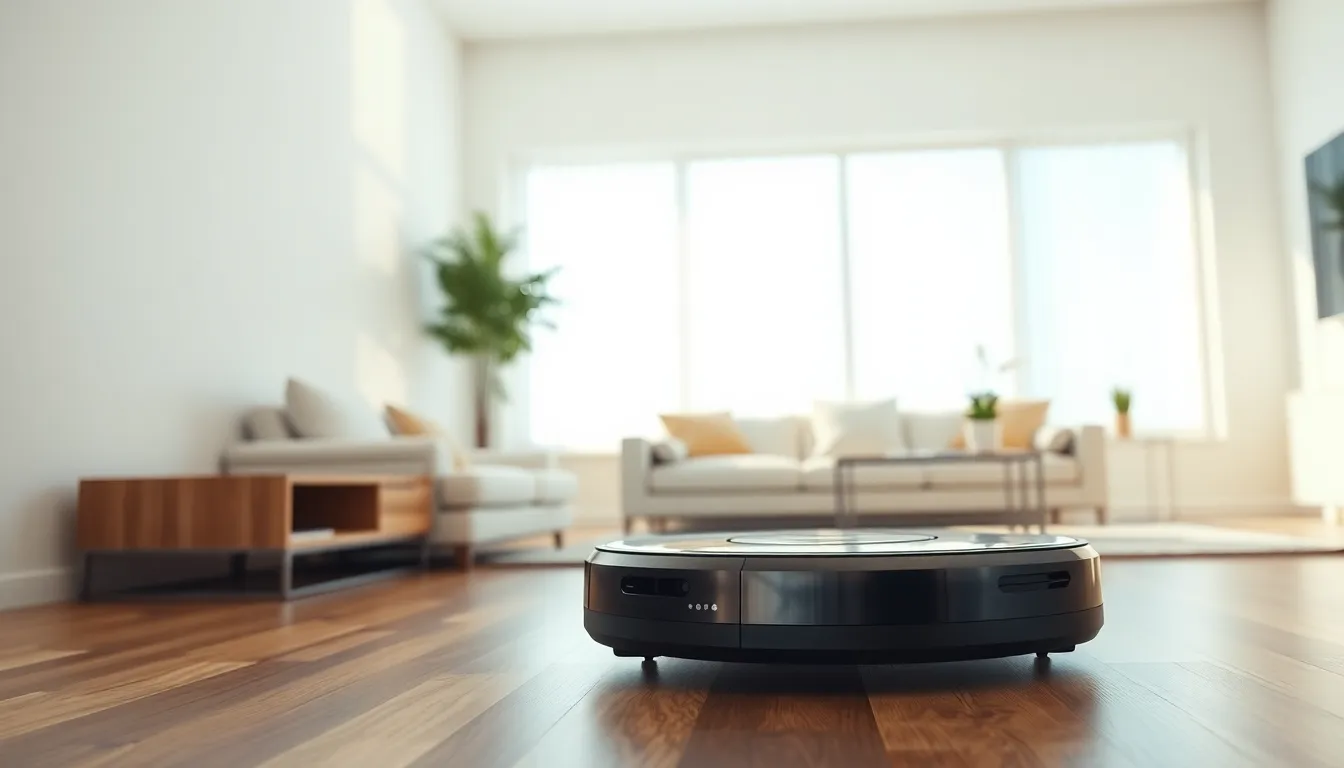Imagine a world where cleaning is as simple as pressing a button. No more wrestling with vacuum cords or dodging dust bunnies like they’re ninja assassins. Automated cleaning is revolutionizing how people maintain their spaces, making it easier, quicker, and a whole lot more fun.
From robotic vacuums that whiz around like tiny R2-D2s to smart mops that glide effortlessly across floors, these gadgets are designed to take the grunt work out of household chores. They don’t just save time; they give back precious hours that can be spent on the things that truly matter—like binge-watching that new series or finally tackling that book pile.
So why not let technology do the heavy lifting? Dive into the world of automated cleaning and discover how it can transform your home into a spotless sanctuary without breaking a sweat.
Table of Contents
ToggleOverview Of Automated Cleaning
Automated cleaning refers to the use of technology to perform cleaning tasks with minimal human intervention. Devices such as robotic vacuums and automated mops enable users to maintain cleanliness effortlessly. Many of these devices utilize sensors and advanced navigation systems to identify dirt and navigate spaces, ensuring thorough cleaning without the need for manual labor.
Robotic vacuums stand out for their efficiency. They can cover various floor types, including hardwood, tile, and carpet. Cleansing cycles usually last from 60 to 120 minutes, allowing for extensive cleaning in a single session. Equipped with features like auto-recharging, these vacuums resume cleaning when fully charged.
Automated mops, on the other hand, offer unique benefits. Some models combine sweeping and mopping functions, offering a comprehensive cleaning solution. Many use microfiber pads and eco-friendly cleaning solutions, targeting stains and spills effectively. Users appreciate how these devices can sanitize floors while reducing water usage.
Smart home integration enhances the appeal of automated cleaning. Many devices connect with home assistants, allowing for voice commands and scheduling. This feature adds convenience, letting individuals set cleaning times that suit their lifestyles.
The proliferation of automated cleaning technology shows a growing trend toward efficiency in home maintenance. This shift not only simplifies chores but also allows individuals to spend more time on activities they enjoy. As technology continues to develop, the automated cleaning market promises further innovations that improve user experiences.
Benefits Of Automated Cleaning

Automated cleaning offers numerous advantages, making household upkeep simple and efficient.
Time Efficiency
Automated cleaning significantly reduces the time spent on chores. Users can program devices to clean while they focus on other activities. Robotic vacuums typically operate independently, navigating through rooms without human intervention. Scheduling options let users designate specific cleaning times, allowing them to come home to a tidy space. In many cases, tasks that once took hours can now be completed in a fraction of the time. By optimizing schedules, automated devices enhance productivity, giving users more time for leisure or family.
Cost-Effectiveness
Investing in automated cleaning devices proves financially beneficial over time. While the initial purchase price may seem high, the reduction in cleaning labor costs accumulates quickly. Users save on professional cleaning services, which can be expensive for regular upkeep. Additionally, energy-efficient cleaning devices typically consume less power than traditional cleaners. Long-term savings also arise from the durability of automated devices, which often withstand wear and tear better than manual tools. Automated cleaning thus becomes a smart choice for budget-conscious households.
Enhanced Cleaning Quality
Automated cleaning improves overall cleanliness in homes. Many devices utilize advanced sensors to detect dirt and debris, consistently delivering thorough results. Robotic vacuums adapt to various floor types, ensuring a comprehensive clean across surfaces. Furthermore, automated mops often employ eco-friendly solutions, reducing chemical use while enhancing sanitation. Regular cleaning cycles diminish dust accumulation, benefiting allergy sufferers. Enhanced cleaning quality creates a healthier living environment, making automated cleaning an essential aspect of modern home maintenance.
Types Of Automated Cleaning Solutions
Various automated cleaning solutions cater to different cleaning needs. These devices streamline housekeeping tasks, ensuring efficient maintenance.
Robotic Vacuums
Robotic vacuums autonomously navigate various floor types while removing dust and debris. Equipped with advanced sensors, they detect obstacles and adjust their cleaning paths accordingly. Many models feature multiple cleaning modes, allowing users to customize settings based on specific requirements. Users benefit from programmable schedules, enabling automatic cleaning even in their absence. Well-known brands like Roomba, Eufy, and Neato lead the market with innovative designs and performance.
Automated Floor Scrubbers
Automated floor scrubbers focus on deep cleaning hard surfaces, such as tile and hardwood. These machines apply cleaning solutions and scrub floors efficiently, ensuring thorough sanitation. Equipped with large water tanks, they reduce the need for frequent refills during cleaning sessions. Many commercial-grade models incorporate powerful suction systems that minimize drying time. Businesses often rely on automated floor scrubbers to maintain cleanliness in high-traffic areas, providing enhanced sanitation and hygiene.
AI-Powered Cleaning Systems
AI-powered cleaning systems leverage advanced algorithms for precise and efficient cleaning routines. These systems learn user preferences and optimize cleaning patterns over time, ensuring thorough results. Integration with smart home technology allows for easy management through voice commands or mobile applications. Users often benefit from enhanced scheduling options, enabling cleaning during off-peak hours for added convenience. Brands focusing on AI cleaning solutions continuously improve their offerings, leading to smarter, more effective cleaning experiences.
Challenges In Automated Cleaning
Automated cleaning solutions face several challenges that can affect their effectiveness and user satisfaction.
Initial Investment Costs
High initial investment costs pose a significant barrier. Many robotic vacuums and automated mops can range from $200 to over $1,000. Consumers often hesitate to spend this amount without guaranteed performance. Evaluating long-term savings helps justify the investment. Potential buyers must also consider additional costs, such as replacements for worn-out parts and consumables. These factors can discourage first-time users from adopting automated cleaning technology.
Maintenance And Repairs
Regular maintenance is crucial for optimal performance. Users often overlook routine cleaning and upkeep of the devices, leading to decreased efficiency. Battery lifespans typically range from 1 to 3 years, requiring users to replace them periodically. Additionally, consumers may encounter issues with clogging or malfunctioning sensors, demanding repairs or replacements. Staying aware of maintenance needs can enhance device longevity and performance.
Integration With Existing Systems
Integration with existing systems can be complex. Users often find that automated cleaning devices require compatibility with smart home technology. Issues may arise when devices use different communication protocols. Ensuring seamless connectivity with smart assistants can enhance user convenience. Users who struggle with integration may miss out on the full benefits of automation. Prioritizing compatible devices during the selection process can minimize these challenges.
Future Trends In Automated Cleaning
Emerging trends in automated cleaning technologies pave the way for enhanced user experiences. Increased integration of artificial intelligence enables devices to learn from user behavior and improve cleaning efficiency. More intuitive interfaces provide seamless control over cleaning schedules, making devices user-friendly.
Advancements in sensor technology allow for improved navigation and obstacle avoidance. Upcoming models of robotic vacuums incorporate LiDAR sensors, which create precise maps of living spaces, ensuring thorough cleaning. Innovative features such as self-emptying dustbins reduce user involvement even further.
Smart home integration continues to expand, connecting cleaning devices with other household appliances. With voice control becoming standard, users can command devices to start cleaning routines effortlessly. Compatibility with home security systems offers added convenience, allowing users to monitor and control their cleaning devices from anywhere.
Sustainability remains a key focus for future cleaning solutions. Automated mops and vacuums more frequently utilize eco-friendly cleaning agents, minimizing environmental impact. Products designed for energy efficiency end up lowering long-term costs, appealing to budget-conscious consumers.
Developments in cleaning speed and coverage produce major improvements. Upcoming robotic vacuums may cover larger areas in shorter time spans, allowing for efficient cleaning of extensive spaces. Market analyses indicate that future trends will likely prioritize automated cleaning solutions for commercial settings, enhancing hygiene in workplaces.
Adoption of machine learning principles results in predictive cleaning algorithms. Such algorithms adapt cleaning schedules based on real-time data and user habits. The evolution of automated cleaning suggests a promising future filled with greater convenience, efficiency, and environmental consciousness.
Automated cleaning technology is reshaping how households approach maintenance. With devices like robotic vacuums and smart mops, users can enjoy a cleaner home without dedicating hours to chores. The efficiency and convenience offered by these innovations not only save time but also enhance overall cleanliness.
As technology advances, the integration of AI and improved sensors promises even greater efficiency and user satisfaction. While challenges such as initial costs and maintenance exist, the long-term benefits of automated cleaning solutions are undeniable. Embracing these technologies can lead to a more effortless approach to home care, allowing individuals to reclaim their time for what truly matters.



